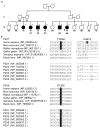Purinergic receptors P2RX4 and P2RX7 in familial multiple sclerosis
- PMID: 28326637
- PMCID: PMC5429140
- DOI: 10.1002/humu.23218
Purinergic receptors P2RX4 and P2RX7 in familial multiple sclerosis
Abstract
Genetic variants in the purinergic receptors P2RX4 and P2RX7 have been shown to affect susceptibility to multiple sclerosis (MS). In this study, we set out to evaluate whether rare coding variants of major effect could also be identified in these purinergic receptors. Sequencing analysis of P2RX4 and P2RX7 in 193 MS patients and 100 controls led to the identification of a rare three variant haplotype (P2RX7 rs140915863:C>T [p.T205M], P2RX7 rs201921967:A>G [p.N361S], and P2RX4 rs765866317:G>A [p.G135S]) segregating with disease in a multi-incident family with six family members diagnosed with MS (logarithm of odds = 3.07). Functional analysis of this haplotype in HEK293 cells revealed impaired P2X7 surface expression (P < 0.01), resulting in over 95% inhibition of adenosine triphosphate (ATP)-induced pore function (P < 0.001) and a marked reduction in phagocytic ability (P < 0.05). In addition, transfected cells showed 40% increased peak ATP-induced inward current (P < 0.01), and a greater Ca2+ response to the P2X4 135S variant compared with wild type (P < 0.0001). Our study nominates rare genetic variants in P2RX4 and P2RX7 as major genetic contributors to disease, further supporting a role for these purinergic receptors in MS and the disruption of transmembrane cation channels leading to impairment of phagocytosis as the pathological mechanisms of disease.
Keywords: P2RX4, P2RX7, P2X4, P2X7, variant; familial, Mendelian, multiple sclerosis; mutation.
© 2017 Wiley Periodicals, Inc.
Figures



Comment in
-
New rare genetic variants in multiple sclerosis.J Neurol. 2019 Jan;266(1):278-280. doi: 10.1007/s00415-018-9128-9. J Neurol. 2019. PMID: 30460446 Free PMC article. No abstract available.
References
-
- Bours MJ, Swennen EL, Di Virgilio F, Cronstein BN, Dagnelie PC. Adenosine 5’-triphosphate and adenosine as endogenous signaling molecules in immunity and inflammation. Pharmacol Ther. 2006;112:358–404. - PubMed
-
- Buell G, Chessell IP, Michel AD, Collo G, Salazzo M, Herren S, Gretener D, Grahames C, Kaur R, Kosco-Vilbois MH, Humphrey PP. Blockade of human P2X7 receptor function with a monoclonal antibody. Blood. 1998;92:3521–3528. - PubMed
Publication types
MeSH terms
Substances
Grants and funding
LinkOut - more resources
Full Text Sources
Other Literature Sources
Medical
Molecular Biology Databases
Miscellaneous

